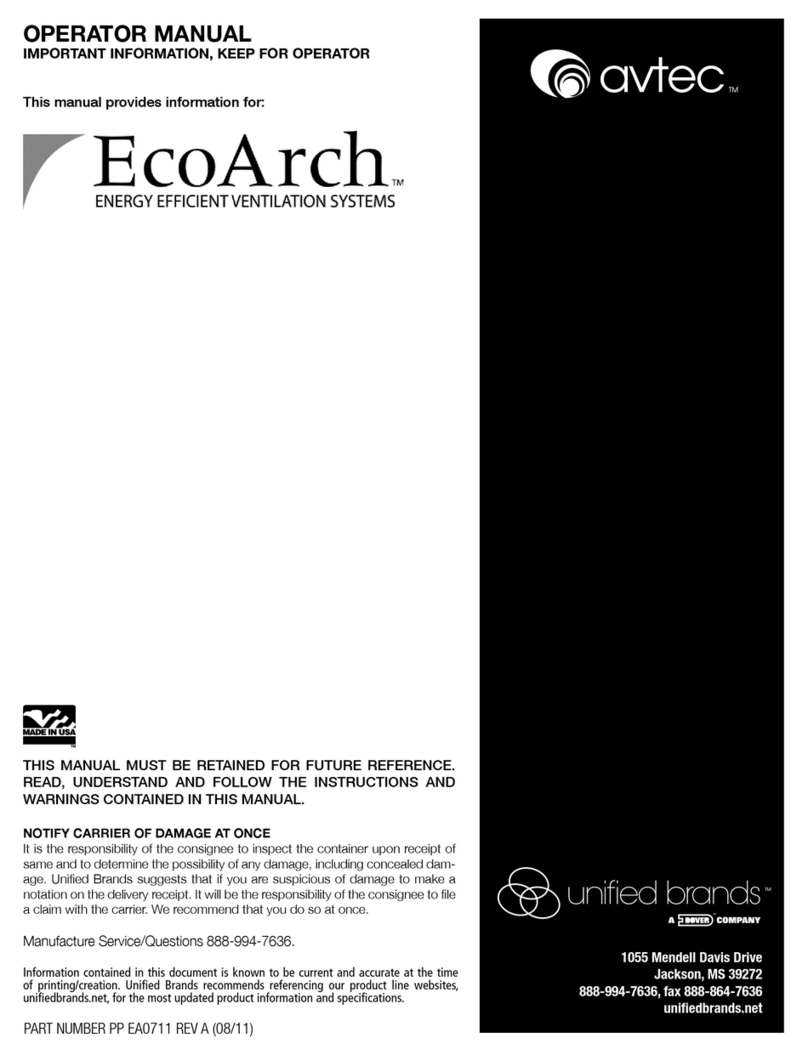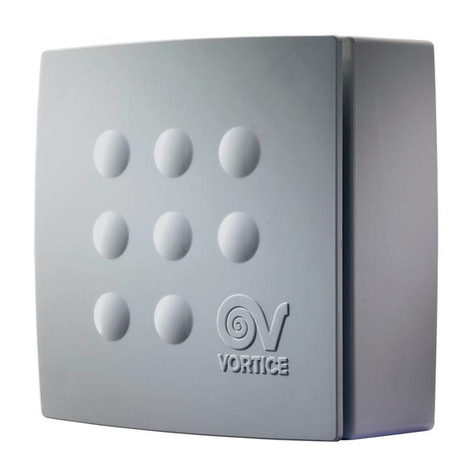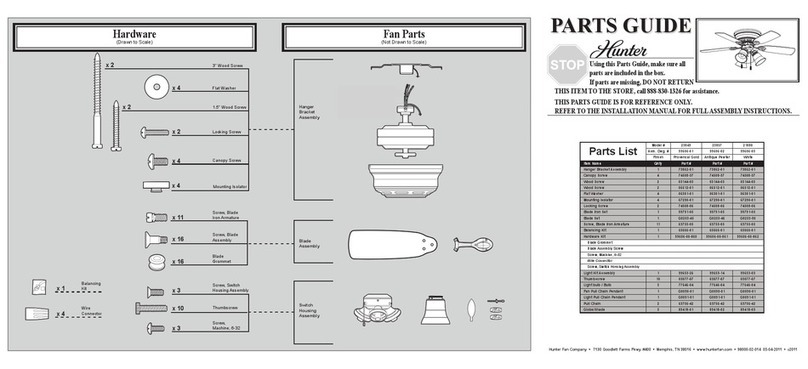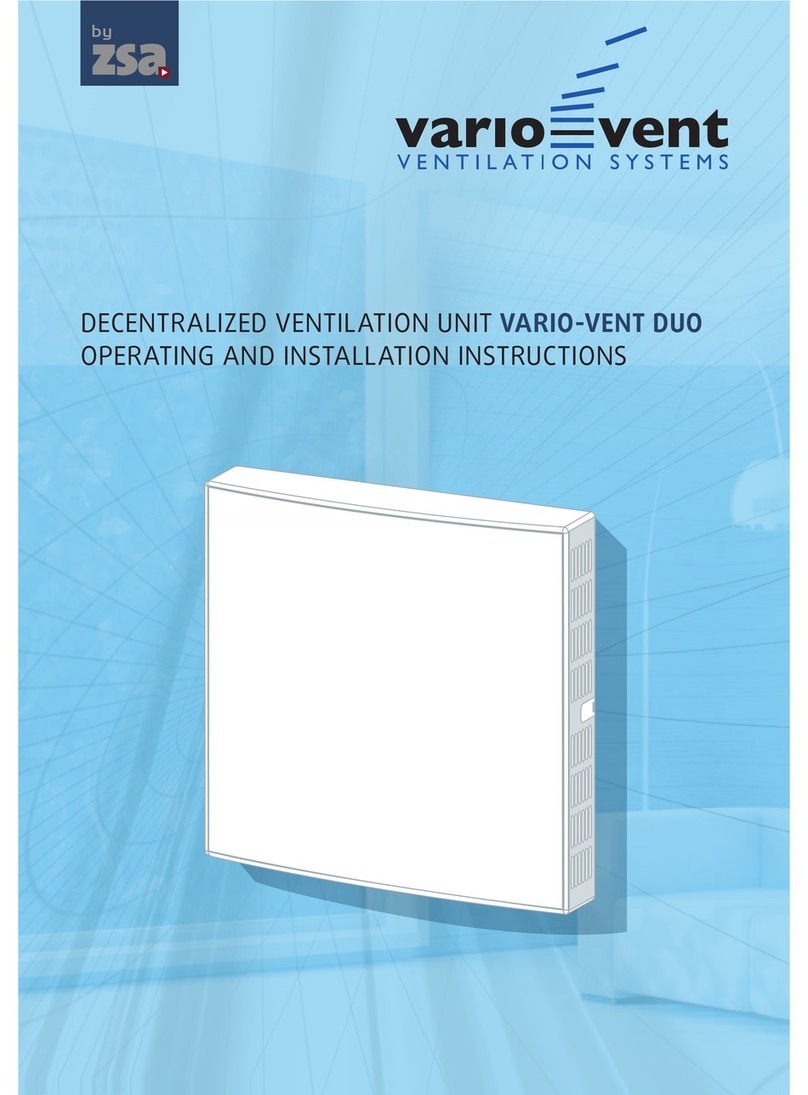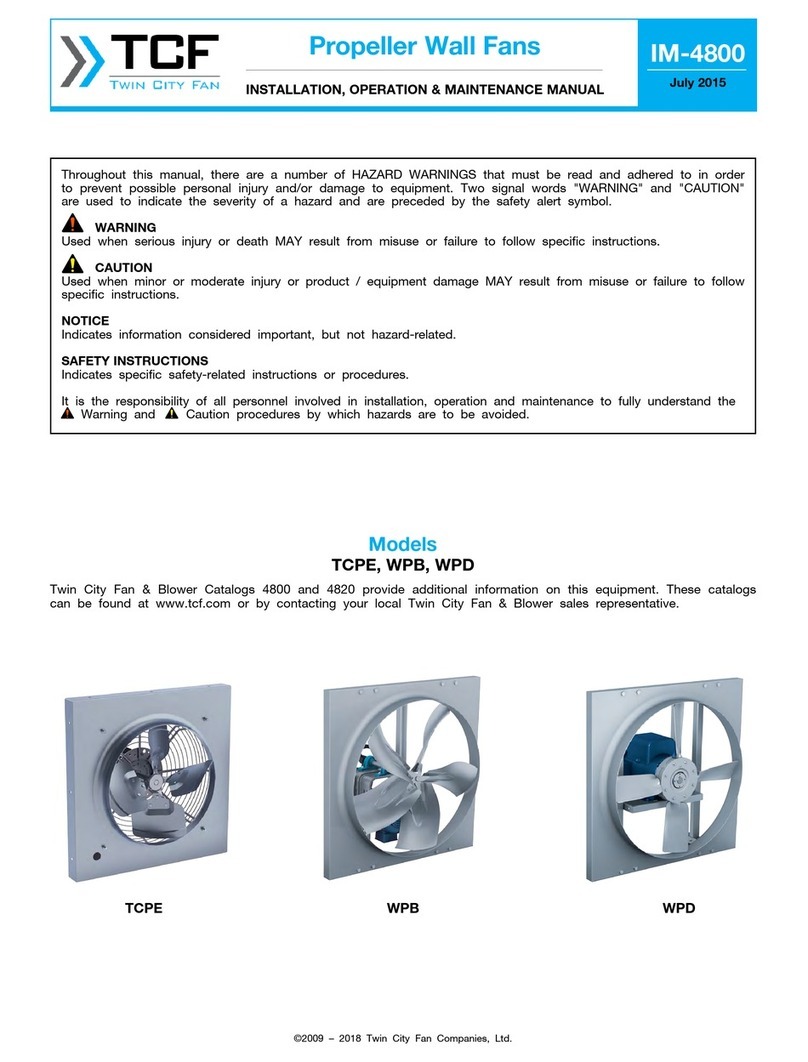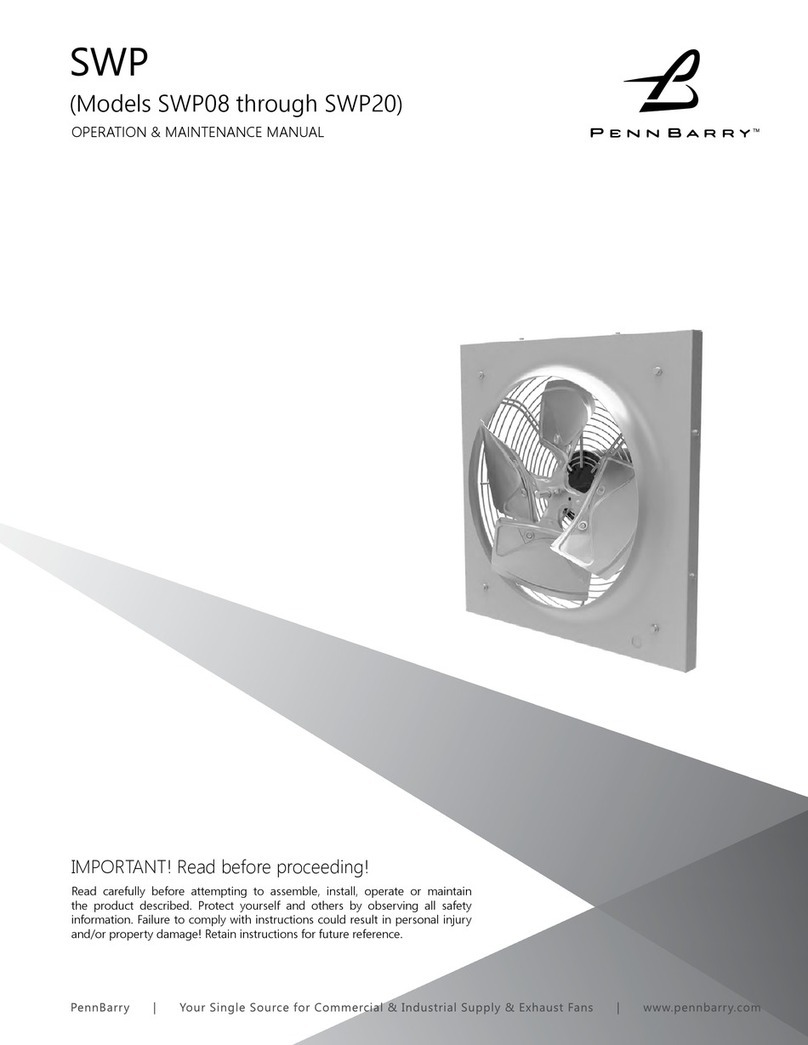EVOAQ EX-TW180DC User manual

Fan Installation Manual
Please take the time to read these instructions in full before
commencing your installation.
Careful planning prior to starting work will guarantee the
fastest and best results regarding the installation.
Working in the ceiling space can be a hazard, and all
safety precautions should be used to ensure the
safety of yourself and any others.
EVOAQ
Air Quality Innovation
Bathroom Extraction
Fan Model
EX-TW180DC
Software Version
V2.14
Manual Version
V3.3.0 10-2023
Bathroom
Extraction

Installation Manual
180mm Low-Voltage DC Through-Wall/Ceiling Fan for
Bathroom Extraction
Thank you for your purchase of our company’s product. It has been manufactured following
current technical safety regulations and is in compliance with AS/NZ60335 standard.
Please read this instruction booklet carefully before installing or starting up the
product.
It contains important information on personal and user safety measures to be followed while
installing, using, and carrying out maintenance work on the equipment. Once the product
has been installed, please hand this booklet to the end user.
Before installing the fan, it is important to understand the way this fan functions.
The fan is designed to be continuously powered.
When first powered on, the fan will run at trickle speed for 30 seconds to initialise the
sensors, and then increase to about 50% speed. It will run at this speed for 2 minutes to
purge the bathroom and learn the environment.
Over the next 10 minutes the fan will gradually slow down until it reaches trickle speed
again. The fan will now be monitoring the bathroom for a change in the environment (e.g.
steam is generated). On detecting such a change, the fan will respond and increase the
speed accordingly. Once the environment has been restored, the fan will once again slow
down to trickle speed.
This fan model does not include an external boost switch option. Please refer to
page 4 for more information.
INSTALLATION OVERVIEW
Before commencing installation, select a suitable place for the fan to be installed in the
external wall. Locate and avoid wall studs when determining fan placement. This fan is
powered by a low-voltage DC power supply and as such is suitable to be placed in wet areas
inside the bathroom (see image 2).
Using the provided cutting template, drill a 185mm hole through the internal wall for the
fan, either using a circular hole saw or other suitable means. Cut a 152mm round hole
through the external wall for the cowl, ensuring the two holes are as aligned as possible.
Making sure that power is turned off, wire the fan power lead as per the wiring diagram (see
image 1), then mount the fan and grille on the internal wall. Take care to ensure the power
cable is not cinched or damaged as the fan case is placed into the wall. Place a short length
of ducting over the fan’s 150mm spigot from outside and tape into place.
Place the other end of the ducting over the cowl and tape into place. Position the cowl inside
the 150mm hole. Mount the cowl onto the wall with the screws provided. Check that both
the fan case and cowl are level and flush with the wall, and that the fan can spin freely
before turning on power to the fan.
Once the fan is mounted, replace the face plate and screw in place, making sure the grille is
positioned correctly and no wires are cinched beneath the grille or face plate.
Note: wiring mains power should only be carried out by a registered electrician.
Once the fan is in installed, place a short length of 150mm aluminium ducting over the fan
spigot from outside, then install a cowl or louvre grille on the other side as required.
Please note:
Excessive ducting and sharp bends lower the fan’s performance. If installing as a
through-ceiling fan ensure the ducting is long enough, with gradual bends, before cutting it.
Important information for the safety of installers and user:
Installation must only be carried out by qualified persons. Make sure that the installation
complies with the applicable building and electrical regulations.
This appliance is not intended for use by young children or infirm persons unless they have
been adequately supervised by a responsible person to ensure that they can use the appli-
ance safely. Young children should be supervised to ensure that they do not play with the
appliance.
This apparatus must not be used in explosive or corrosive atmospheres. If a fan is going to
be installed to extract air from premises where a boiler or other combustion apparatus are
installed, make sure that the building has sufficient air intakes to assure adequate
combustion. The extractor outlet must not be connected to a duct used to exhaust smoke or
fumes from any appliance that uses gas or any other type of fuel.
TRANSPORT AND MANIPULATION
The packaging used for this apparatus has been designed to support normal transporting
conditions. The apparatus must always be transported in its original packaging as not doing
so could deform or damage the product. Do not place heavy weights on the packed product
and avoid knocking or dropping it.
The product should be stored in a dry place in its original packaging, protected from dust
and dirt until it is installed in its final location. Do not accept delivery if the apparatus is not
in its original packaging or shows clear signs of having been manipulated in any way.
Check that the apparatus is in perfect condition while unpacking. Any fault or damage
caused in origin is covered by our company guarantee. Please make sure that the apparatus
coincides with the product you have ordered and that the details on the rating label fulfil
your requirements.
ELECTRICAL CONNECTION
The extractor fan must be connected to a single-phase mains network, with the specific
voltage and frequency according to the specifications on the fan rating label and in
accordance with New Zealand electrical standards.
Please note that this model of fan is not fitted with a power plug and must therefore be wired
with a fixed permanent connection.
In case of damage to the power plug, cord, or device itself, switch off the device and do not
tamper with it. Damaged product must only be repaired or replaced exclusively by the
manufacturer or by an appointed representative. Failure to comply with the above may
endanger the safety of people and cause possible damage to the whole system.
SAFETY DURING INSTALLATION
Make sure there are no loose elements near the fan, as they could run the risk of being
sucked up by it. If it is going to be installed in a duct, check that it is clear of any element
that could be sucked up by the fan. When installing an apparatus, make sure that all the
fittings are in place and that the structure which supports it is resistant enough to bear its
weight at full functioning power.
Before installing the fan, make sure the mains supply is disconnected, even if the fan is
switched off.
If the fan is installed in a duct, the duct must be used for the extraction system only.
STARTING UP THE FAN
Fans may have delayed startup, or may operate under the control of the inbuilt controlling
electronics included with the fan. Always take extreme care as the fan may start
unexpectedly. Always disconnect the fan from power during maintenance.
Before starting up the fan, ensure that:
•
•
•
•
When starting up the fan, ensure that:
•
•
If the circuit protection device is tripping during operation, the apparatus must be quickly
disconnected from the mains supply. The whole installation should be carefully checked
before trying to start up the machine again.
MAINTENANCE AND REPAIR
Before servicing the fan, make sure it is disconnected from the mains supply - even if it has
previously been switched off. Avoid the risk of anyone else plugging it in while you’re
working on it.
The fan must be regularly inspected. These inspections should consider the fan’s working
conditions, ensuring no dirt or dust builds up on the propeller, turbine, motor or grilles. This
could be dangerous and perceptibly shorten the fan’s lifespan. While cleaning, take extra
care not to damage the propeller.
All maintenance work should be carried out in strict compliance with New Zealand safety
regulations.
All our products contain repairable or replaceable parts. Repair or replacement of these parts
should only be handled by the manufacturer. In the case of damage or malfunction of the
fan, please contact the manufacturer or installer to arrange for repair. Please note that a
small fee may apply for repair services not covered under warranty.
EXTERNAL WALL SWITCH - OPTIONAL EXTRA
Please note, this particular fan model does not have a switch included and as such does not
have any switch functionality enabled.
A wall switch option may be available upon request. If you would like to add an external
switch input to the fan, please contact your installer or supplier to discuss available options.
FAN WIRING (IMG 1)
This fan is powered by 12V DC. A 12V power supply is included for powering the fan. This
power supply includes two sets of wires - one is mains input to power the power supply, the
other is the 12V output to power the fan. The fan is required to be permanently powered.
Please refer to the image below to ensure the fan is wired correctly to prevent damaging the
fan.
BATHROOM ZONES (IMG 2)
This through-wall fan model is suitable to be placed inside all 3 zones as shown on the
image below.
This fan is classified as low-voltage equipment. Only low voltage equipment may be installed
in zone 1. This includes wet areas - directly above the shower or bath (up to 2250mm above
floor level) and 150mm around the shower cubicle.
THRU-WALL BATHROOM FAN INSTALLATION (IMG 3-6)
THRU-WALL BATHROOM KIT ASSEMBLY (IMG 7-9)
THRU-CEILING KIT INSTALLATION (IMG 10)
For further information, please contact EvolutionFX NZ Limited
email: info@evolutionfx.co.nz
phone: +64 9 558 5590
EVOAQ
Air Quality Innovation
EVOAQ Bathroom Extraction
Page 2 www.evoaq.co.nz

Installation Manual
180mm Low-Voltage DC Through-Wall/Ceiling Fan for
Bathroom Extraction
Thank you for your purchase of our company’s product. It has been manufactured following
current technical safety regulations and is in compliance with AS/NZ60335 standard.
Please read this instruction booklet carefully before installing or starting up the
product.
It contains important information on personal and user safety measures to be followed while
installing, using, and carrying out maintenance work on the equipment. Once the product
has been installed, please hand this booklet to the end user.
Before installing the fan, it is important to understand the way this fan functions.
The fan is designed to be continuously powered.
When first powered on, the fan will run at trickle speed for 30 seconds to initialise the
sensors, and then increase to about 50% speed. It will run at this speed for 2 minutes to
purge the bathroom and learn the environment.
Over the next 10 minutes the fan will gradually slow down until it reaches trickle speed
again. The fan will now be monitoring the bathroom for a change in the environment (e.g.
steam is generated). On detecting such a change, the fan will respond and increase the
speed accordingly. Once the environment has been restored, the fan will once again slow
down to trickle speed.
This fan model does not include an external boost switch option. Please refer to
page 4 for more information.
INSTALLATION OVERVIEW
Before commencing installation, select a suitable place for the fan to be installed in the
external wall. Locate and avoid wall studs when determining fan placement. This fan is
powered by a low-voltage DC power supply and as such is suitable to be placed in wet areas
inside the bathroom (see image 2).
Using the provided cutting template, drill a 185mm hole through the internal wall for the
fan, either using a circular hole saw or other suitable means. Cut a 152mm round hole
through the external wall for the cowl, ensuring the two holes are as aligned as possible.
Making sure that power is turned off, wire the fan power lead as per the wiring diagram (see
image 1), then mount the fan and grille on the internal wall. Take care to ensure the power
cable is not cinched or damaged as the fan case is placed into the wall. Place a short length
of ducting over the fan’s 150mm spigot from outside and tape into place.
Place the other end of the ducting over the cowl and tape into place. Position the cowl inside
the 150mm hole. Mount the cowl onto the wall with the screws provided. Check that both
the fan case and cowl are level and flush with the wall, and that the fan can spin freely
before turning on power to the fan.
Once the fan is mounted, replace the face plate and screw in place, making sure the grille is
positioned correctly and no wires are cinched beneath the grille or face plate.
Note: wiring mains power should only be carried out by a registered electrician.
Once the fan is in installed, place a short length of 150mm aluminium ducting over the fan
spigot from outside, then install a cowl or louvre grille on the other side as required.
Please note:
Excessive ducting and sharp bends lower the fan’s performance. If installing as a
through-ceiling fan ensure the ducting is long enough, with gradual bends, before cutting it.
Important information for the safety of installers and user:
Installation must only be carried out by qualified persons. Make sure that the installation
complies with the applicable building and electrical regulations.
This appliance is not intended for use by young children or infirm persons unless they have
been adequately supervised by a responsible person to ensure that they can use the appli-
ance safely. Young children should be supervised to ensure that they do not play with the
appliance.
This apparatus must not be used in explosive or corrosive atmospheres. If a fan is going to
be installed to extract air from premises where a boiler or other combustion apparatus are
installed, make sure that the building has sufficient air intakes to assure adequate
combustion. The extractor outlet must not be connected to a duct used to exhaust smoke or
fumes from any appliance that uses gas or any other type of fuel.
TRANSPORT AND MANIPULATION
The packaging used for this apparatus has been designed to support normal transporting
conditions. The apparatus must always be transported in its original packaging as not doing
so could deform or damage the product. Do not place heavy weights on the packed product
and avoid knocking or dropping it.
The product should be stored in a dry place in its original packaging, protected from dust
and dirt until it is installed in its final location. Do not accept delivery if the apparatus is not
in its original packaging or shows clear signs of having been manipulated in any way.
Check that the apparatus is in perfect condition while unpacking. Any fault or damage
caused in origin is covered by our company guarantee. Please make sure that the apparatus
coincides with the product you have ordered and that the details on the rating label fulfil
your requirements.
ELECTRICAL CONNECTION
The extractor fan must be connected to a single-phase mains network, with the specific
voltage and frequency according to the specifications on the fan rating label and in
accordance with New Zealand electrical standards.
Please note that this model of fan is not fitted with a power plug and must therefore be wired
with a fixed permanent connection.
In case of damage to the power plug, cord, or device itself, switch off the device and do not
tamper with it. Damaged product must only be repaired or replaced exclusively by the
manufacturer or by an appointed representative. Failure to comply with the above may
endanger the safety of people and cause possible damage to the whole system.
SAFETY DURING INSTALLATION
Make sure there are no loose elements near the fan, as they could run the risk of being
sucked up by it. If it is going to be installed in a duct, check that it is clear of any element
that could be sucked up by the fan. When installing an apparatus, make sure that all the
fittings are in place and that the structure which supports it is resistant enough to bear its
weight at full functioning power.
Before installing the fan, make sure the mains supply is disconnected, even if the fan is
switched off.
If the fan is installed in a duct, the duct must be used for the extraction system only.
STARTING UP THE FAN
Fans may have delayed startup, or may operate under the control of the inbuilt controlling
electronics included with the fan. Always take extreme care as the fan may start
unexpectedly. Always disconnect the fan from power during maintenance.
Before starting up the fan, ensure that:
•
•
•
•
When starting up the fan, ensure that:
•
•
If the circuit protection device is tripping during operation, the apparatus must be quickly
disconnected from the mains supply. The whole installation should be carefully checked
before trying to start up the machine again.
MAINTENANCE AND REPAIR
Before servicing the fan, make sure it is disconnected from the mains supply - even if it has
previously been switched off. Avoid the risk of anyone else plugging it in while you’re
working on it.
The fan must be regularly inspected. These inspections should consider the fan’s working
conditions, ensuring no dirt or dust builds up on the propeller, turbine, motor or grilles. This
could be dangerous and perceptibly shorten the fan’s lifespan. While cleaning, take extra
care not to damage the propeller.
All maintenance work should be carried out in strict compliance with New Zealand safety
regulations.
All our products contain repairable or replaceable parts. Repair or replacement of these parts
should only be handled by the manufacturer. In the case of damage or malfunction of the
fan, please contact the manufacturer or installer to arrange for repair. Please note that a
small fee may apply for repair services not covered under warranty.
EXTERNAL WALL SWITCH - OPTIONAL EXTRA
Please note, this particular fan model does not have a switch included and as such does not
have any switch functionality enabled.
A wall switch option may be available upon request. If you would like to add an external
switch input to the fan, please contact your installer or supplier to discuss available options.
FAN WIRING (IMG 1)
This fan is powered by 12V DC. A 12V power supply is included for powering the fan. This
power supply includes two sets of wires - one is mains input to power the power supply, the
other is the 12V output to power the fan. The fan is required to be permanently powered.
Please refer to the image below to ensure the fan is wired correctly to prevent damaging the
fan.
BATHROOM ZONES (IMG 2)
This through-wall fan model is suitable to be placed inside all 3 zones as shown on the
image below.
This fan is classified as low-voltage equipment. Only low voltage equipment may be installed
in zone 1. This includes wet areas - directly above the shower or bath (up to 2250mm above
floor level) and 150mm around the shower cubicle.
THRU-WALL BATHROOM FAN INSTALLATION (IMG 3-6)
THRU-WALL BATHROOM KIT ASSEMBLY (IMG 7-9)
THRU-CEILING KIT INSTALLATION (IMG 10)
For further information, please contact EvolutionFX NZ Limited
email: info@evolutionfx.co.nz
phone: +64 9 558 5590
EVOAQ
Air Quality Innovation
EVOAQ Bathroom Extraction
Page 3www.evoaq.co.nz

Installation Manual
180mm Low-Voltage DC Through-Wall/Ceiling Fan for
Bathroom Extraction
Thank you for your purchase of our company’s product. It has been manufactured following
current technical safety regulations and is in compliance with AS/NZ60335 standard.
Please read this instruction booklet carefully before installing or starting up the
product.
It contains important information on personal and user safety measures to be followed while
installing, using, and carrying out maintenance work on the equipment. Once the product
has been installed, please hand this booklet to the end user.
Before installing the fan, it is important to understand the way this fan functions.
The fan is designed to be continuously powered.
When first powered on, the fan will run at trickle speed for 30 seconds to initialise the
sensors, and then increase to about 50% speed. It will run at this speed for 2 minutes to
purge the bathroom and learn the environment.
Over the next 10 minutes the fan will gradually slow down until it reaches trickle speed
again. The fan will now be monitoring the bathroom for a change in the environment (e.g.
steam is generated). On detecting such a change, the fan will respond and increase the
speed accordingly. Once the environment has been restored, the fan will once again slow
down to trickle speed.
This fan model does not include an external boost switch option. Please refer to
page 4 for more information.
INSTALLATION OVERVIEW
Before commencing installation, select a suitable place for the fan to be installed in the
external wall. Locate and avoid wall studs when determining fan placement. This fan is
powered by a low-voltage DC power supply and as such is suitable to be placed in wet areas
inside the bathroom (see image 2).
Using the provided cutting template, drill a 185mm hole through the internal wall for the
fan, either using a circular hole saw or other suitable means. Cut a 152mm round hole
through the external wall for the cowl, ensuring the two holes are as aligned as possible.
Making sure that power is turned off, wire the fan power lead as per the wiring diagram (see
image 1), then mount the fan and grille on the internal wall. Take care to ensure the power
cable is not cinched or damaged as the fan case is placed into the wall. Place a short length
of ducting over the fan’s 150mm spigot from outside and tape into place.
Place the other end of the ducting over the cowl and tape into place. Position the cowl inside
the 150mm hole. Mount the cowl onto the wall with the screws provided. Check that both
the fan case and cowl are level and flush with the wall, and that the fan can spin freely
before turning on power to the fan.
Once the fan is mounted, replace the face plate and screw in place, making sure the grille is
positioned correctly and no wires are cinched beneath the grille or face plate.
Note: wiring mains power should only be carried out by a registered electrician.
Once the fan is in installed, place a short length of 150mm aluminium ducting over the fan
spigot from outside, then install a cowl or louvre grille on the other side as required.
Please note:
Excessive ducting and sharp bends lower the fan’s performance. If installing as a
through-ceiling fan ensure the ducting is long enough, with gradual bends, before cutting it.
Important information for the safety of installers and user:
Installation must only be carried out by qualified persons. Make sure that the installation
complies with the applicable building and electrical regulations.
This appliance is not intended for use by young children or infirm persons unless they have
been adequately supervised by a responsible person to ensure that they can use the appli-
ance safely. Young children should be supervised to ensure that they do not play with the
appliance.
This apparatus must not be used in explosive or corrosive atmospheres. If a fan is going to
be installed to extract air from premises where a boiler or other combustion apparatus are
installed, make sure that the building has sufficient air intakes to assure adequate
combustion. The extractor outlet must not be connected to a duct used to exhaust smoke or
fumes from any appliance that uses gas or any other type of fuel.
TRANSPORT AND MANIPULATION
The packaging used for this apparatus has been designed to support normal transporting
conditions. The apparatus must always be transported in its original packaging as not doing
so could deform or damage the product. Do not place heavy weights on the packed product
and avoid knocking or dropping it.
The product should be stored in a dry place in its original packaging, protected from dust
and dirt until it is installed in its final location. Do not accept delivery if the apparatus is not
in its original packaging or shows clear signs of having been manipulated in any way.
Check that the apparatus is in perfect condition while unpacking. Any fault or damage
caused in origin is covered by our company guarantee. Please make sure that the apparatus
coincides with the product you have ordered and that the details on the rating label fulfil
your requirements.
ELECTRICAL CONNECTION
The extractor fan must be connected to a single-phase mains network, with the specific
voltage and frequency according to the specifications on the fan rating label and in
accordance with New Zealand electrical standards.
Please note that this model of fan is not fitted with a power plug and must therefore be wired
with a fixed permanent connection.
In case of damage to the power plug, cord, or device itself, switch off the device and do not
tamper with it. Damaged product must only be repaired or replaced exclusively by the
manufacturer or by an appointed representative. Failure to comply with the above may
endanger the safety of people and cause possible damage to the whole system.
SAFETY DURING INSTALLATION
Make sure there are no loose elements near the fan, as they could run the risk of being
sucked up by it. If it is going to be installed in a duct, check that it is clear of any element
that could be sucked up by the fan. When installing an apparatus, make sure that all the
fittings are in place and that the structure which supports it is resistant enough to bear its
weight at full functioning power.
Before installing the fan, make sure the mains supply is disconnected, even if the fan is
switched off.
If the fan is installed in a duct, the duct must be used for the extraction system only.
STARTING UP THE FAN
Fans may have delayed startup, or may operate under the control of the inbuilt controlling
electronics included with the fan. Always take extreme care as the fan may start
unexpectedly. Always disconnect the fan from power during maintenance.
Before starting up the fan, ensure that:
•
•
•
•
When starting up the fan, ensure that:
•
•
If the circuit protection device is tripping during operation, the apparatus must be quickly
disconnected from the mains supply. The whole installation should be carefully checked
before trying to start up the machine again.
MAINTENANCE AND REPAIR
Before servicing the fan, make sure it is disconnected from the mains supply - even if it has
previously been switched off. Avoid the risk of anyone else plugging it in while you’re
working on it.
The fan must be regularly inspected. These inspections should consider the fan’s working
conditions, ensuring no dirt or dust builds up on the propeller, turbine, motor or grilles. This
could be dangerous and perceptibly shorten the fan’s lifespan. While cleaning, take extra
care not to damage the propeller.
All maintenance work should be carried out in strict compliance with New Zealand safety
regulations.
All our products contain repairable or replaceable parts. Repair or replacement of these parts
should only be handled by the manufacturer. In the case of damage or malfunction of the
fan, please contact the manufacturer or installer to arrange for repair. Please note that a
small fee may apply for repair services not covered under warranty.
EXTERNAL WALL SWITCH - OPTIONAL EXTRA
Please note, this particular fan model does not have a switch included and as such does not
have any switch functionality enabled.
A wall switch option may be available upon request. If you would like to add an external
switch input to the fan, please contact your installer or supplier to discuss available options.
FAN WIRING (IMG 1)
This fan is powered by 12V DC. A 12V power supply is included for powering the fan. This
power supply includes two sets of wires - one is mains input to power the power supply, the
other is the 12V output to power the fan. The fan is required to be permanently powered.
Please refer to the image below to ensure the fan is wired correctly to prevent damaging the
fan.
BATHROOM ZONES (IMG 2)
This through-wall fan model is suitable to be placed inside all 3 zones as shown on the
image below.
This fan is classified as low-voltage equipment. Only low voltage equipment may be installed
in zone 1. This includes wet areas - directly above the shower or bath (up to 2250mm above
floor level) and 150mm around the shower cubicle.
THRU-WALL BATHROOM FAN INSTALLATION (IMG 3-6)
THRU-WALL BATHROOM KIT ASSEMBLY (IMG 7-9)
THRU-CEILING KIT INSTALLATION (IMG 10)
For further information, please contact EvolutionFX NZ Limited
email: info@evolutionfx.co.nz
phone: +64 9 558 5590
EVOAQ
Air Quality Innovation
EVOAQ Bathroom Extraction
Page 4 www.evoaq.co.nz
The fan is well secured and the electrical connections have been carried out correctly;
Any electrical safety devices are correctly connected, adequately adjusted and ready for
use;
The wire and electrical connection inputs are correctly sealed and water-tight;
If the fan has been mounted in a duct, the duct is clear of any loose material that could
be sucked up by the fan.
The propeller turns in the correct direction;
There are no abnormal vibrations.

Installation Manual
180mm Low-Voltage DC Through-Wall/Ceiling Fan for
Bathroom Extraction
Thank you for your purchase of our company’s product. It has been manufactured following
current technical safety regulations and is in compliance with AS/NZ60335 standard.
Please read this instruction booklet carefully before installing or starting up the
product.
It contains important information on personal and user safety measures to be followed while
installing, using, and carrying out maintenance work on the equipment. Once the product
has been installed, please hand this booklet to the end user.
Before installing the fan, it is important to understand the way this fan functions.
The fan is designed to be continuously powered.
When first powered on, the fan will run at trickle speed for 30 seconds to initialise the
sensors, and then increase to about 50% speed. It will run at this speed for 2 minutes to
purge the bathroom and learn the environment.
Over the next 10 minutes the fan will gradually slow down until it reaches trickle speed
again. The fan will now be monitoring the bathroom for a change in the environment (e.g.
steam is generated). On detecting such a change, the fan will respond and increase the
speed accordingly. Once the environment has been restored, the fan will once again slow
down to trickle speed.
This fan model does not include an external boost switch option. Please refer to
page 4 for more information.
INSTALLATION OVERVIEW
Before commencing installation, select a suitable place for the fan to be installed in the
external wall. Locate and avoid wall studs when determining fan placement. This fan is
powered by a low-voltage DC power supply and as such is suitable to be placed in wet areas
inside the bathroom (see image 2).
Using the provided cutting template, drill a 185mm hole through the internal wall for the
fan, either using a circular hole saw or other suitable means. Cut a 152mm round hole
through the external wall for the cowl, ensuring the two holes are as aligned as possible.
Making sure that power is turned off, wire the fan power lead as per the wiring diagram (see
image 1), then mount the fan and grille on the internal wall. Take care to ensure the power
cable is not cinched or damaged as the fan case is placed into the wall. Place a short length
of ducting over the fan’s 150mm spigot from outside and tape into place.
Place the other end of the ducting over the cowl and tape into place. Position the cowl inside
the 150mm hole. Mount the cowl onto the wall with the screws provided. Check that both
the fan case and cowl are level and flush with the wall, and that the fan can spin freely
before turning on power to the fan.
Once the fan is mounted, replace the face plate and screw in place, making sure the grille is
positioned correctly and no wires are cinched beneath the grille or face plate.
Note: wiring mains power should only be carried out by a registered electrician.
Once the fan is in installed, place a short length of 150mm aluminium ducting over the fan
spigot from outside, then install a cowl or louvre grille on the other side as required.
Please note:
Excessive ducting and sharp bends lower the fan’s performance. If installing as a
through-ceiling fan ensure the ducting is long enough, with gradual bends, before cutting it.
Important information for the safety of installers and user:
Installation must only be carried out by qualified persons. Make sure that the installation
complies with the applicable building and electrical regulations.
This appliance is not intended for use by young children or infirm persons unless they have
been adequately supervised by a responsible person to ensure that they can use the appli-
ance safely. Young children should be supervised to ensure that they do not play with the
appliance.
This apparatus must not be used in explosive or corrosive atmospheres. If a fan is going to
be installed to extract air from premises where a boiler or other combustion apparatus are
installed, make sure that the building has sufficient air intakes to assure adequate
combustion. The extractor outlet must not be connected to a duct used to exhaust smoke or
fumes from any appliance that uses gas or any other type of fuel.
TRANSPORT AND MANIPULATION
The packaging used for this apparatus has been designed to support normal transporting
conditions. The apparatus must always be transported in its original packaging as not doing
so could deform or damage the product. Do not place heavy weights on the packed product
and avoid knocking or dropping it.
The product should be stored in a dry place in its original packaging, protected from dust
and dirt until it is installed in its final location. Do not accept delivery if the apparatus is not
in its original packaging or shows clear signs of having been manipulated in any way.
Check that the apparatus is in perfect condition while unpacking. Any fault or damage
caused in origin is covered by our company guarantee. Please make sure that the apparatus
coincides with the product you have ordered and that the details on the rating label fulfil
your requirements.
ELECTRICAL CONNECTION
The extractor fan must be connected to a single-phase mains network, with the specific
voltage and frequency according to the specifications on the fan rating label and in
accordance with New Zealand electrical standards.
Please note that this model of fan is not fitted with a power plug and must therefore be wired
with a fixed permanent connection.
In case of damage to the power plug, cord, or device itself, switch off the device and do not
tamper with it. Damaged product must only be repaired or replaced exclusively by the
manufacturer or by an appointed representative. Failure to comply with the above may
endanger the safety of people and cause possible damage to the whole system.
SAFETY DURING INSTALLATION
Make sure there are no loose elements near the fan, as they could run the risk of being
sucked up by it. If it is going to be installed in a duct, check that it is clear of any element
that could be sucked up by the fan. When installing an apparatus, make sure that all the
fittings are in place and that the structure which supports it is resistant enough to bear its
weight at full functioning power.
Before installing the fan, make sure the mains supply is disconnected, even if the fan is
switched off.
If the fan is installed in a duct, the duct must be used for the extraction system only.
STARTING UP THE FAN
Fans may have delayed startup, or may operate under the control of the inbuilt controlling
electronics included with the fan. Always take extreme care as the fan may start
unexpectedly. Always disconnect the fan from power during maintenance.
Before starting up the fan, ensure that:
•
•
•
•
When starting up the fan, ensure that:
•
•
If the circuit protection device is tripping during operation, the apparatus must be quickly
disconnected from the mains supply. The whole installation should be carefully checked
before trying to start up the machine again.
MAINTENANCE AND REPAIR
Before servicing the fan, make sure it is disconnected from the mains supply - even if it has
previously been switched off. Avoid the risk of anyone else plugging it in while you’re
working on it.
The fan must be regularly inspected. These inspections should consider the fan’s working
conditions, ensuring no dirt or dust builds up on the propeller, turbine, motor or grilles. This
could be dangerous and perceptibly shorten the fan’s lifespan. While cleaning, take extra
care not to damage the propeller.
All maintenance work should be carried out in strict compliance with New Zealand safety
regulations.
All our products contain repairable or replaceable parts. Repair or replacement of these parts
should only be handled by the manufacturer. In the case of damage or malfunction of the
fan, please contact the manufacturer or installer to arrange for repair. Please note that a
small fee may apply for repair services not covered under warranty.
EXTERNAL WALL SWITCH - OPTIONAL EXTRA
Please note, this particular fan model does not have a switch included and as such does not
have any switch functionality enabled.
A wall switch option may be available upon request. If you would like to add an external
switch input to the fan, please contact your installer or supplier to discuss available options.
FAN WIRING (IMG 1)
This fan is powered by 12V DC. A 12V power supply is included for powering the fan. This
power supply includes two sets of wires - one is mains input to power the power supply, the
other is the 12V output to power the fan. The fan is required to be permanently powered.
Please refer to the image below to ensure the fan is wired correctly to prevent damaging the
fan.
BATHROOM ZONES (IMG 2)
This through-wall fan model is suitable to be placed inside all 3 zones as shown on the
image below.
This fan is classified as low-voltage equipment. Only low voltage equipment may be installed
in zone 1. This includes wet areas - directly above the shower or bath (up to 2250mm above
floor level) and 150mm around the shower cubicle.
THRU-WALL BATHROOM FAN INSTALLATION (IMG 3-6)
THRU-WALL BATHROOM KIT ASSEMBLY (IMG 7-9)
THRU-CEILING KIT INSTALLATION (IMG 10)
For further information, please contact EvolutionFX NZ Limited
email: info@evolutionfx.co.nz
phone: +64 9 558 5590
EVOAQ
Air Quality Innovation
EVOAQ Bathroom Extraction
12V DC Power Supply
Input
Output
12V DC Output - 2-Wire Cable*
Brown = 12V
Blue = 0V
*12V Cable should already be wired into fan
230V AC Input - 3-Wire Cable
Blue = Neutral
Brown = Phase
Green = Earth
Clip grille into place
3.
Secure grille with screw
4.
2.
Mount fan with 4 screws
1.
Cut hole for fan in wall
Page 5www.evoaq.co.nz

Installation Manual
180mm Low-Voltage DC Through-Wall/Ceiling Fan for
Bathroom Extraction
Thank you for your purchase of our company’s product. It has been manufactured following
current technical safety regulations and is in compliance with AS/NZ60335 standard.
Please read this instruction booklet carefully before installing or starting up the
product.
It contains important information on personal and user safety measures to be followed while
installing, using, and carrying out maintenance work on the equipment. Once the product
has been installed, please hand this booklet to the end user.
Before installing the fan, it is important to understand the way this fan functions.
The fan is designed to be continuously powered.
When first powered on, the fan will run at trickle speed for 30 seconds to initialise the
sensors, and then increase to about 50% speed. It will run at this speed for 2 minutes to
purge the bathroom and learn the environment.
Over the next 10 minutes the fan will gradually slow down until it reaches trickle speed
again. The fan will now be monitoring the bathroom for a change in the environment (e.g.
steam is generated). On detecting such a change, the fan will respond and increase the
speed accordingly. Once the environment has been restored, the fan will once again slow
down to trickle speed.
This fan model does not include an external boost switch option. Please refer to
page 4 for more information.
INSTALLATION OVERVIEW
Before commencing installation, select a suitable place for the fan to be installed in the
external wall. Locate and avoid wall studs when determining fan placement. This fan is
powered by a low-voltage DC power supply and as such is suitable to be placed in wet areas
inside the bathroom (see image 2).
Using the provided cutting template, drill a 185mm hole through the internal wall for the
fan, either using a circular hole saw or other suitable means. Cut a 152mm round hole
through the external wall for the cowl, ensuring the two holes are as aligned as possible.
Making sure that power is turned off, wire the fan power lead as per the wiring diagram (see
image 1), then mount the fan and grille on the internal wall. Take care to ensure the power
cable is not cinched or damaged as the fan case is placed into the wall. Place a short length
of ducting over the fan’s 150mm spigot from outside and tape into place.
Place the other end of the ducting over the cowl and tape into place. Position the cowl inside
the 150mm hole. Mount the cowl onto the wall with the screws provided. Check that both
the fan case and cowl are level and flush with the wall, and that the fan can spin freely
before turning on power to the fan.
Once the fan is mounted, replace the face plate and screw in place, making sure the grille is
positioned correctly and no wires are cinched beneath the grille or face plate.
Note: wiring mains power should only be carried out by a registered electrician.
Once the fan is in installed, place a short length of 150mm aluminium ducting over the fan
spigot from outside, then install a cowl or louvre grille on the other side as required.
Please note:
Excessive ducting and sharp bends lower the fan’s performance. If installing as a
through-ceiling fan ensure the ducting is long enough, with gradual bends, before cutting it.
Important information for the safety of installers and user:
Installation must only be carried out by qualified persons. Make sure that the installation
complies with the applicable building and electrical regulations.
This appliance is not intended for use by young children or infirm persons unless they have
been adequately supervised by a responsible person to ensure that they can use the appli-
ance safely. Young children should be supervised to ensure that they do not play with the
appliance.
This apparatus must not be used in explosive or corrosive atmospheres. If a fan is going to
be installed to extract air from premises where a boiler or other combustion apparatus are
installed, make sure that the building has sufficient air intakes to assure adequate
combustion. The extractor outlet must not be connected to a duct used to exhaust smoke or
fumes from any appliance that uses gas or any other type of fuel.
TRANSPORT AND MANIPULATION
The packaging used for this apparatus has been designed to support normal transporting
conditions. The apparatus must always be transported in its original packaging as not doing
so could deform or damage the product. Do not place heavy weights on the packed product
and avoid knocking or dropping it.
The product should be stored in a dry place in its original packaging, protected from dust
and dirt until it is installed in its final location. Do not accept delivery if the apparatus is not
in its original packaging or shows clear signs of having been manipulated in any way.
Check that the apparatus is in perfect condition while unpacking. Any fault or damage
caused in origin is covered by our company guarantee. Please make sure that the apparatus
coincides with the product you have ordered and that the details on the rating label fulfil
your requirements.
ELECTRICAL CONNECTION
The extractor fan must be connected to a single-phase mains network, with the specific
voltage and frequency according to the specifications on the fan rating label and in
accordance with New Zealand electrical standards.
Please note that this model of fan is not fitted with a power plug and must therefore be wired
with a fixed permanent connection.
In case of damage to the power plug, cord, or device itself, switch off the device and do not
tamper with it. Damaged product must only be repaired or replaced exclusively by the
manufacturer or by an appointed representative. Failure to comply with the above may
endanger the safety of people and cause possible damage to the whole system.
SAFETY DURING INSTALLATION
Make sure there are no loose elements near the fan, as they could run the risk of being
sucked up by it. If it is going to be installed in a duct, check that it is clear of any element
that could be sucked up by the fan. When installing an apparatus, make sure that all the
fittings are in place and that the structure which supports it is resistant enough to bear its
weight at full functioning power.
Before installing the fan, make sure the mains supply is disconnected, even if the fan is
switched off.
If the fan is installed in a duct, the duct must be used for the extraction system only.
STARTING UP THE FAN
Fans may have delayed startup, or may operate under the control of the inbuilt controlling
electronics included with the fan. Always take extreme care as the fan may start
unexpectedly. Always disconnect the fan from power during maintenance.
Before starting up the fan, ensure that:
•
•
•
•
When starting up the fan, ensure that:
•
•
If the circuit protection device is tripping during operation, the apparatus must be quickly
disconnected from the mains supply. The whole installation should be carefully checked
before trying to start up the machine again.
MAINTENANCE AND REPAIR
Before servicing the fan, make sure it is disconnected from the mains supply - even if it has
previously been switched off. Avoid the risk of anyone else plugging it in while you’re
working on it.
The fan must be regularly inspected. These inspections should consider the fan’s working
conditions, ensuring no dirt or dust builds up on the propeller, turbine, motor or grilles. This
could be dangerous and perceptibly shorten the fan’s lifespan. While cleaning, take extra
care not to damage the propeller.
All maintenance work should be carried out in strict compliance with New Zealand safety
regulations.
All our products contain repairable or replaceable parts. Repair or replacement of these parts
should only be handled by the manufacturer. In the case of damage or malfunction of the
fan, please contact the manufacturer or installer to arrange for repair. Please note that a
small fee may apply for repair services not covered under warranty.
EXTERNAL WALL SWITCH - OPTIONAL EXTRA
Please note, this particular fan model does not have a switch included and as such does not
have any switch functionality enabled.
A wall switch option may be available upon request. If you would like to add an external
switch input to the fan, please contact your installer or supplier to discuss available options.
FAN WIRING (IMG 1)
This fan is powered by 12V DC. A 12V power supply is included for powering the fan. This
power supply includes two sets of wires - one is mains input to power the power supply, the
other is the 12V output to power the fan. The fan is required to be permanently powered.
Please refer to the image below to ensure the fan is wired correctly to prevent damaging the
fan.
BATHROOM ZONES (IMG 2)
This through-wall fan model is suitable to be placed inside all 3 zones as shown on the
image below.
This fan is classified as low-voltage equipment. Only low voltage equipment may be installed
in zone 1. This includes wet areas - directly above the shower or bath (up to 2250mm above
floor level) and 150mm around the shower cubicle.
THRU-WALL BATHROOM FAN INSTALLATION (IMG 3-6)
THRU-WALL BATHROOM KIT ASSEMBLY (IMG 7-9)
THRU-CEILING KIT INSTALLATION (IMG 10)
For further information, please contact EvolutionFX NZ Limited
email: info@evolutionfx.co.nz
phone: +64 9 558 5590
EVOAQ
Air Quality Innovation
EVOAQ Bathroom Extraction
Screw
to wall
Screw
to wall
Ducting covering
both spigots
Fan location
Outside wall
Inside wall
Internal
Fan
Nude
Ducting
Through-wall Kit Layout
External
Cowl
+
Extraction
Fan
Inlet
Grille
Page 6 www.evoaq.co.nz
Extraction
Fan
Grille or
Cowl
Flexi
Ducting
Through-ceiling Kit Layout

Installation Manual
180mm Low-Voltage DC Through-Wall/Ceiling Fan for
Bathroom Extraction
Thank you for your purchase of our company’s product. It has been manufactured following
current technical safety regulations and is in compliance with AS/NZ60335 standard.
Please read this instruction booklet carefully before installing or starting up the
product.
It contains important information on personal and user safety measures to be followed while
installing, using, and carrying out maintenance work on the equipment. Once the product
has been installed, please hand this booklet to the end user.
Before installing the fan, it is important to understand the way this fan functions.
The fan is designed to be continuously powered.
When first powered on, the fan will run at trickle speed for 30 seconds to initialise the
sensors, and then increase to about 50% speed. It will run at this speed for 2 minutes to
purge the bathroom and learn the environment.
Over the next 10 minutes the fan will gradually slow down until it reaches trickle speed
again. The fan will now be monitoring the bathroom for a change in the environment (e.g.
steam is generated). On detecting such a change, the fan will respond and increase the
speed accordingly. Once the environment has been restored, the fan will once again slow
down to trickle speed.
This fan model does not include an external boost switch option. Please refer to
page 4 for more information.
INSTALLATION OVERVIEW
Before commencing installation, select a suitable place for the fan to be installed in the
external wall. Locate and avoid wall studs when determining fan placement. This fan is
powered by a low-voltage DC power supply and as such is suitable to be placed in wet areas
inside the bathroom (see image 2).
Using the provided cutting template, drill a 185mm hole through the internal wall for the
fan, either using a circular hole saw or other suitable means. Cut a 152mm round hole
through the external wall for the cowl, ensuring the two holes are as aligned as possible.
Making sure that power is turned off, wire the fan power lead as per the wiring diagram (see
image 1), then mount the fan and grille on the internal wall. Take care to ensure the power
cable is not cinched or damaged as the fan case is placed into the wall. Place a short length
of ducting over the fan’s 150mm spigot from outside and tape into place.
Place the other end of the ducting over the cowl and tape into place. Position the cowl inside
the 150mm hole. Mount the cowl onto the wall with the screws provided. Check that both
the fan case and cowl are level and flush with the wall, and that the fan can spin freely
before turning on power to the fan.
Once the fan is mounted, replace the face plate and screw in place, making sure the grille is
positioned correctly and no wires are cinched beneath the grille or face plate.
Note: wiring mains power should only be carried out by a registered electrician.
Once the fan is in installed, place a short length of 150mm aluminium ducting over the fan
spigot from outside, then install a cowl or louvre grille on the other side as required.
Please note:
Excessive ducting and sharp bends lower the fan’s performance. If installing as a
through-ceiling fan ensure the ducting is long enough, with gradual bends, before cutting it.
Important information for the safety of installers and user:
Installation must only be carried out by qualified persons. Make sure that the installation
complies with the applicable building and electrical regulations.
This appliance is not intended for use by young children or infirm persons unless they have
been adequately supervised by a responsible person to ensure that they can use the appli-
ance safely. Young children should be supervised to ensure that they do not play with the
appliance.
This apparatus must not be used in explosive or corrosive atmospheres. If a fan is going to
be installed to extract air from premises where a boiler or other combustion apparatus are
installed, make sure that the building has sufficient air intakes to assure adequate
combustion. The extractor outlet must not be connected to a duct used to exhaust smoke or
fumes from any appliance that uses gas or any other type of fuel.
TRANSPORT AND MANIPULATION
The packaging used for this apparatus has been designed to support normal transporting
conditions. The apparatus must always be transported in its original packaging as not doing
so could deform or damage the product. Do not place heavy weights on the packed product
and avoid knocking or dropping it.
The product should be stored in a dry place in its original packaging, protected from dust
and dirt until it is installed in its final location. Do not accept delivery if the apparatus is not
in its original packaging or shows clear signs of having been manipulated in any way.
Check that the apparatus is in perfect condition while unpacking. Any fault or damage
caused in origin is covered by our company guarantee. Please make sure that the apparatus
coincides with the product you have ordered and that the details on the rating label fulfil
your requirements.
ELECTRICAL CONNECTION
The extractor fan must be connected to a single-phase mains network, with the specific
voltage and frequency according to the specifications on the fan rating label and in
accordance with New Zealand electrical standards.
Please note that this model of fan is not fitted with a power plug and must therefore be wired
with a fixed permanent connection.
In case of damage to the power plug, cord, or device itself, switch off the device and do not
tamper with it. Damaged product must only be repaired or replaced exclusively by the
manufacturer or by an appointed representative. Failure to comply with the above may
endanger the safety of people and cause possible damage to the whole system.
SAFETY DURING INSTALLATION
Make sure there are no loose elements near the fan, as they could run the risk of being
sucked up by it. If it is going to be installed in a duct, check that it is clear of any element
that could be sucked up by the fan. When installing an apparatus, make sure that all the
fittings are in place and that the structure which supports it is resistant enough to bear its
weight at full functioning power.
Before installing the fan, make sure the mains supply is disconnected, even if the fan is
switched off.
If the fan is installed in a duct, the duct must be used for the extraction system only.
STARTING UP THE FAN
Fans may have delayed startup, or may operate under the control of the inbuilt controlling
electronics included with the fan. Always take extreme care as the fan may start
unexpectedly. Always disconnect the fan from power during maintenance.
Before starting up the fan, ensure that:
•
•
•
•
When starting up the fan, ensure that:
•
•
If the circuit protection device is tripping during operation, the apparatus must be quickly
disconnected from the mains supply. The whole installation should be carefully checked
before trying to start up the machine again.
MAINTENANCE AND REPAIR
Before servicing the fan, make sure it is disconnected from the mains supply - even if it has
previously been switched off. Avoid the risk of anyone else plugging it in while you’re
working on it.
The fan must be regularly inspected. These inspections should consider the fan’s working
conditions, ensuring no dirt or dust builds up on the propeller, turbine, motor or grilles. This
could be dangerous and perceptibly shorten the fan’s lifespan. While cleaning, take extra
care not to damage the propeller.
All maintenance work should be carried out in strict compliance with New Zealand safety
regulations.
All our products contain repairable or replaceable parts. Repair or replacement of these parts
should only be handled by the manufacturer. In the case of damage or malfunction of the
fan, please contact the manufacturer or installer to arrange for repair. Please note that a
small fee may apply for repair services not covered under warranty.
EXTERNAL WALL SWITCH - OPTIONAL EXTRA
Please note, this particular fan model does not have a switch included and as such does not
have any switch functionality enabled.
A wall switch option may be available upon request. If you would like to add an external
switch input to the fan, please contact your installer or supplier to discuss available options.
FAN WIRING (IMG 1)
This fan is powered by 12V DC. A 12V power supply is included for powering the fan. This
power supply includes two sets of wires - one is mains input to power the power supply, the
other is the 12V output to power the fan. The fan is required to be permanently powered.
Please refer to the image below to ensure the fan is wired correctly to prevent damaging the
fan.
BATHROOM ZONES (IMG 2)
This through-wall fan model is suitable to be placed inside all 3 zones as shown on the
image below.
This fan is classified as low-voltage equipment. Only low voltage equipment may be installed
in zone 1. This includes wet areas - directly above the shower or bath (up to 2250mm above
floor level) and 150mm around the shower cubicle.
THRU-WALL BATHROOM FAN INSTALLATION (IMG 3-6)
THRU-WALL BATHROOM KIT ASSEMBLY (IMG 7-9)
THRU-CEILING KIT INSTALLATION (IMG 10)
For further information, please contact EvolutionFX NZ Limited
email: [email protected]
phone: +64 9 558 5590
Page 7www.evoaq.co.nz
EVOAQ
Air Quality Innovation
EVOAQ Bathroom Extraction
EX-TW180DC Thru-Wall Fan Specifications
Fan Part Number
Fan Spigot Size
Voltage (V)
Power (W)
Air Flow (L/s)
Static Pressure (Pa)
Noise Level (dB)
Speed (RPM)
Specific Fan Power (SFP)
EX-TW180DC
150mm
12 DC
2.5 - 17
16 ~ 95
240
31
500 ~ 3000
0.108 W/Ls-1
For all our manuals, fan
specifications, system details
and more information visit
www.evoaq.co.nz/downloads
To check which software version is installed
and when your fan was manufactured,
check the label on the fan - located
underneath the face plate (grille) of the fan
Thru-wall DC Extraction Fan EX-TW180DC
EVOAQ TW Extraction Controller installed
Automatic Humidity Control System
Version 2.14 xx/xx/xx
Software version Manufacture date

Page 8 www.evoaq.co.nz
Fully Automatic
Bathroom Extraction.
Just Plug and Play.
Like EVOAQ
on Facebook
Follow evoaqnz
on Instagram
Start-up Boost
30 seconds after being plugged in, the fan
enters a 2-minute startup boost on high
speed to ensure bad or stale air is
removed from the bathroom, before the
fan slowly slows down and begins its
Bathroom Extraction Cycle
Boost Switch - optional
A remote low-voltage switch may be wired
into selected fan models as a ‘boost switch’.
If the switch is on, the fan runs at high
speed. When the switch is turned off again,
the fan slowly slows down and resumes its
Bathroom Extraction Cycle
Automatic Bathroom Extraction Fans
EVOAQ Bathroom Extraction fans work by running at a low trickle speed and constantly
monitoring the moisture levels within the bathroom environment.
In-built controls and sensors in the fan control the fan speed to extract any excess
moisture and protect your bathroom.
Monitor Air
The fan runs at trickle speed
while constantly monitoring the
humidity levels in the bathroom
for any changes
Shower ON
As the shower is turned on,
humidity levels in the
bathroom start rising and
condensation begins to form
Fan Speedup
The fan detects the steam and
increase in humidity and
speeds up to extract the excess
moisture in the bathroom
Shower OFF
Fan Slowdown
As the bathroom humidity
levels return to normal, the fan
slowly starts to slow down and
continues monitoring the air Bathroom
Extraction Cycle
The fan is constantly
sensing the air and
reacting to the bathroom
conditions, to extract
excess moisture and
improve the air quality
in the bathroom
Boost delay
The fan continues running
at high speed to remove
the remaining moisture
from the bathroom
The shower is turned off and
the humidity levels start to
drop in the bathroom
EVOAQ
Air Quality Innovation
EVOAQ Bathroom Extraction
How It Works
Table of contents
Other EVOAQ Fan manuals

EVOAQ
EVOAQ EX-TW150SF User manual

EVOAQ
EVOAQ Home Ventilation User manual
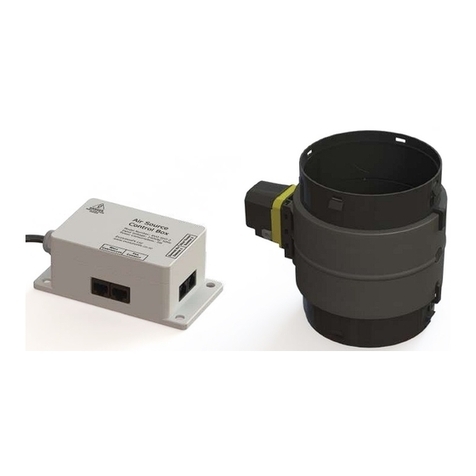
EVOAQ
EVOAQ Summer Upgrade Kit User manual
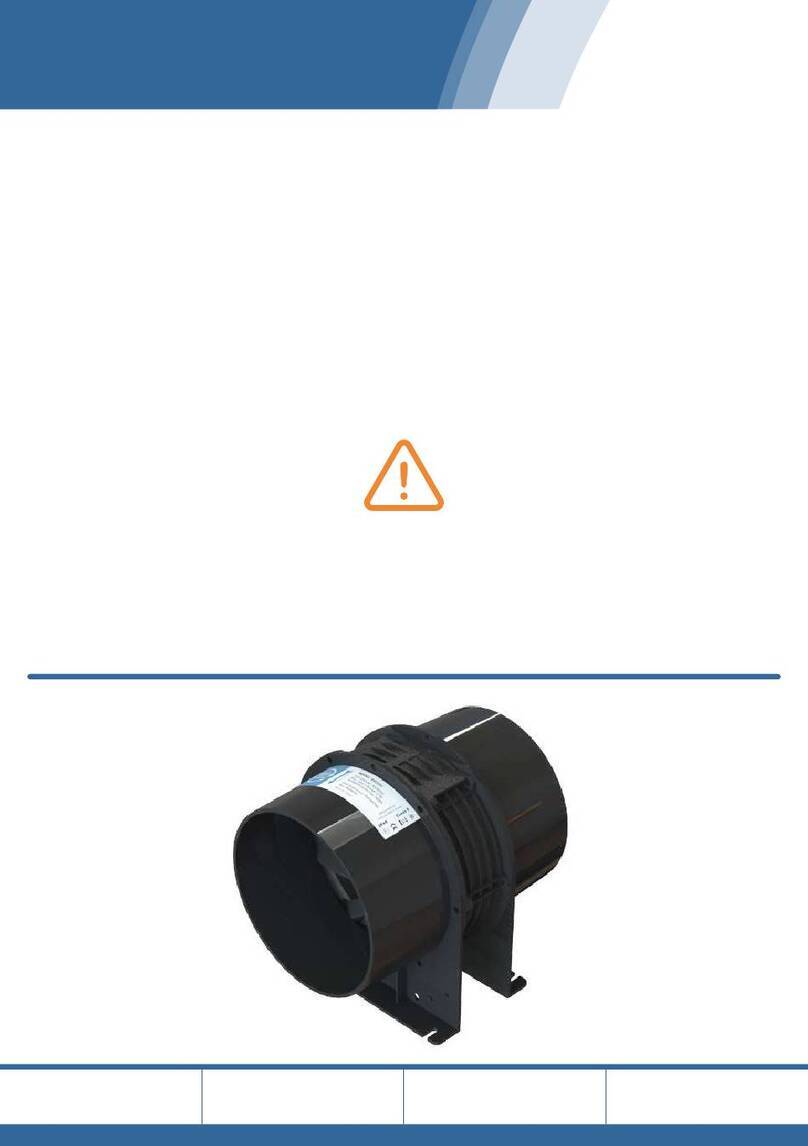
EVOAQ
EVOAQ EX-AX150MC User manual
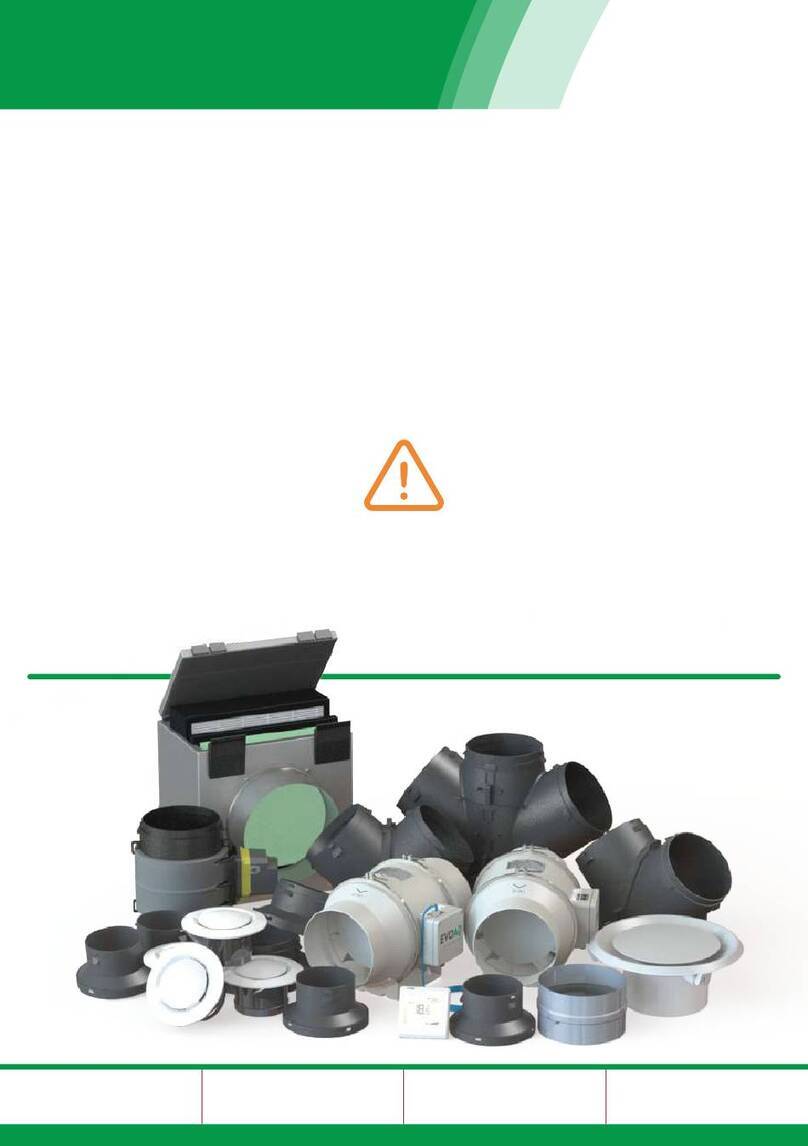
EVOAQ
EVOAQ AQ60 User manual
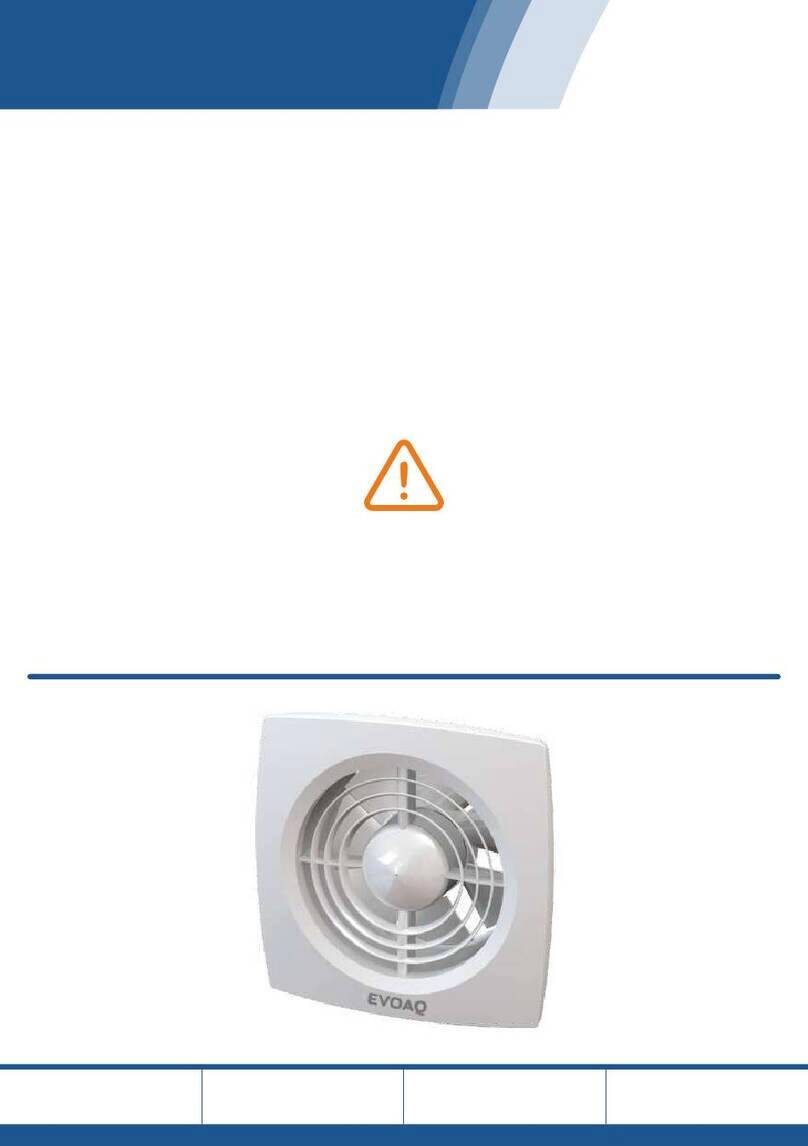
EVOAQ
EVOAQ EX-TW150MC User manual

EVOAQ
EVOAQ AQ60 User manual

EVOAQ
EVOAQ EX-AX150SF User manual
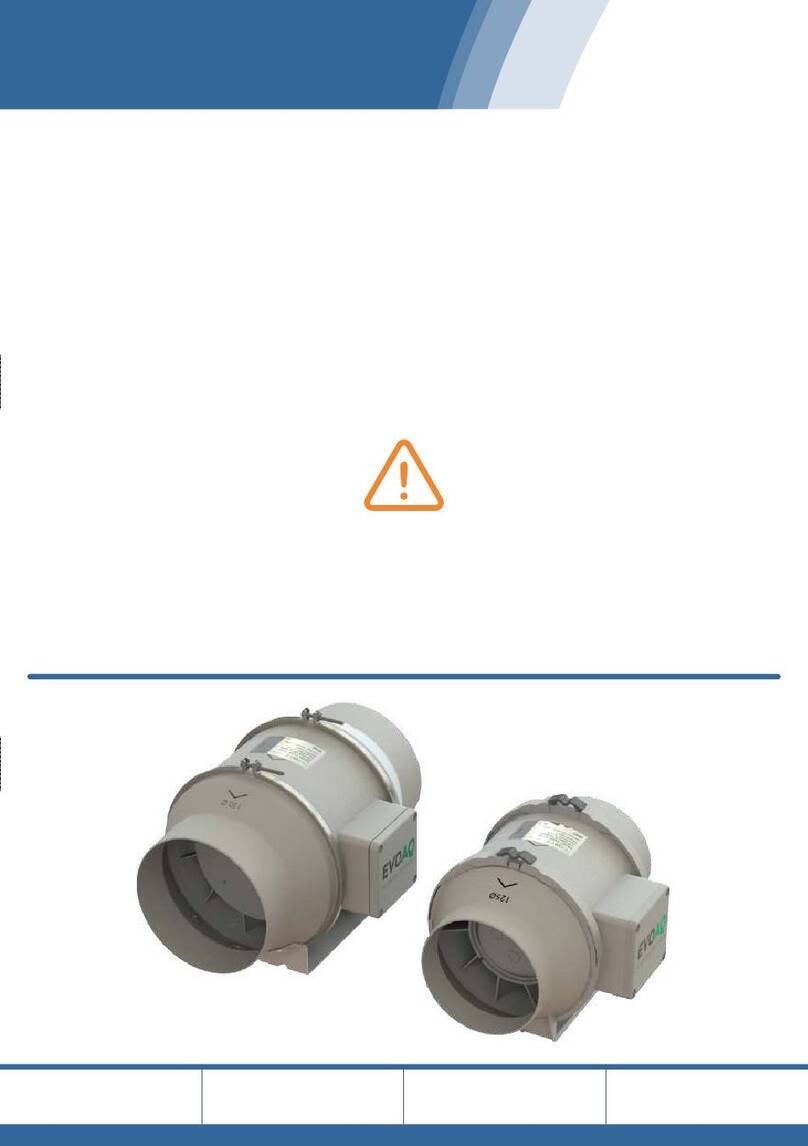
EVOAQ
EVOAQ EX-MF EC Series User manual

EVOAQ
EVOAQ EX-AX150MC User manual
Popular Fan manuals by other brands
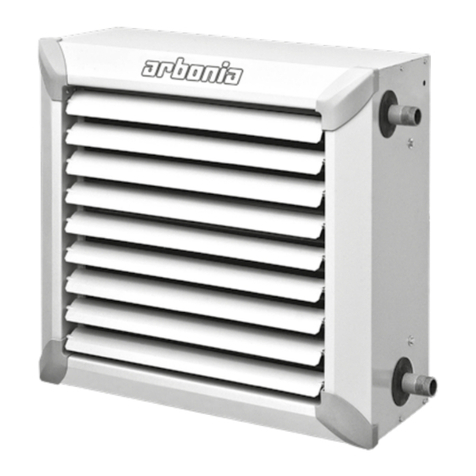
Arbonia
Arbonia DAB Installation and maintenance manual

Harbor Breeze
Harbor Breeze BIRCHMOUNT COVE 41554 installation instructions
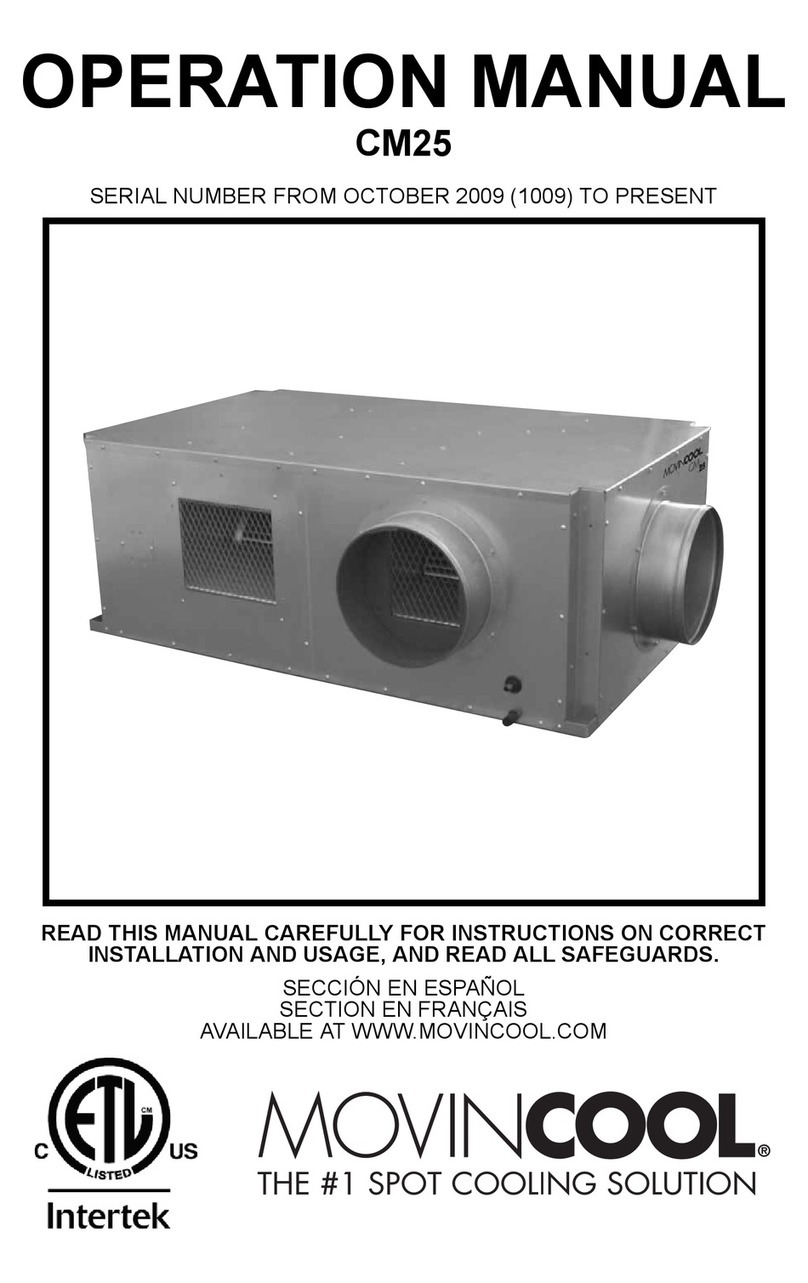
Movincool
Movincool CM 25 Operation manual

Aerovent
Aerovent IM-166 Installation, operation & maintenance manual

Clas Ohlson
Clas Ohlson FT25-U2/Copper-UK manual
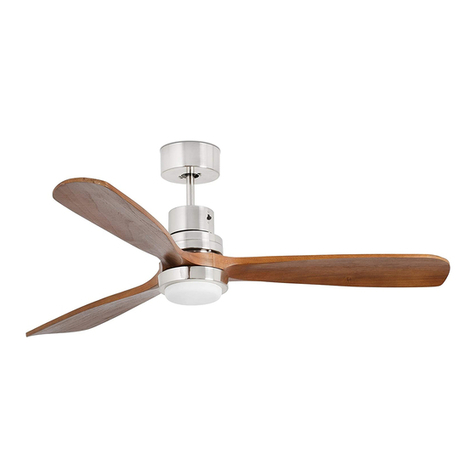
Faro Barcelona
Faro Barcelona 33518 quick start guide


